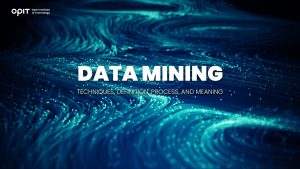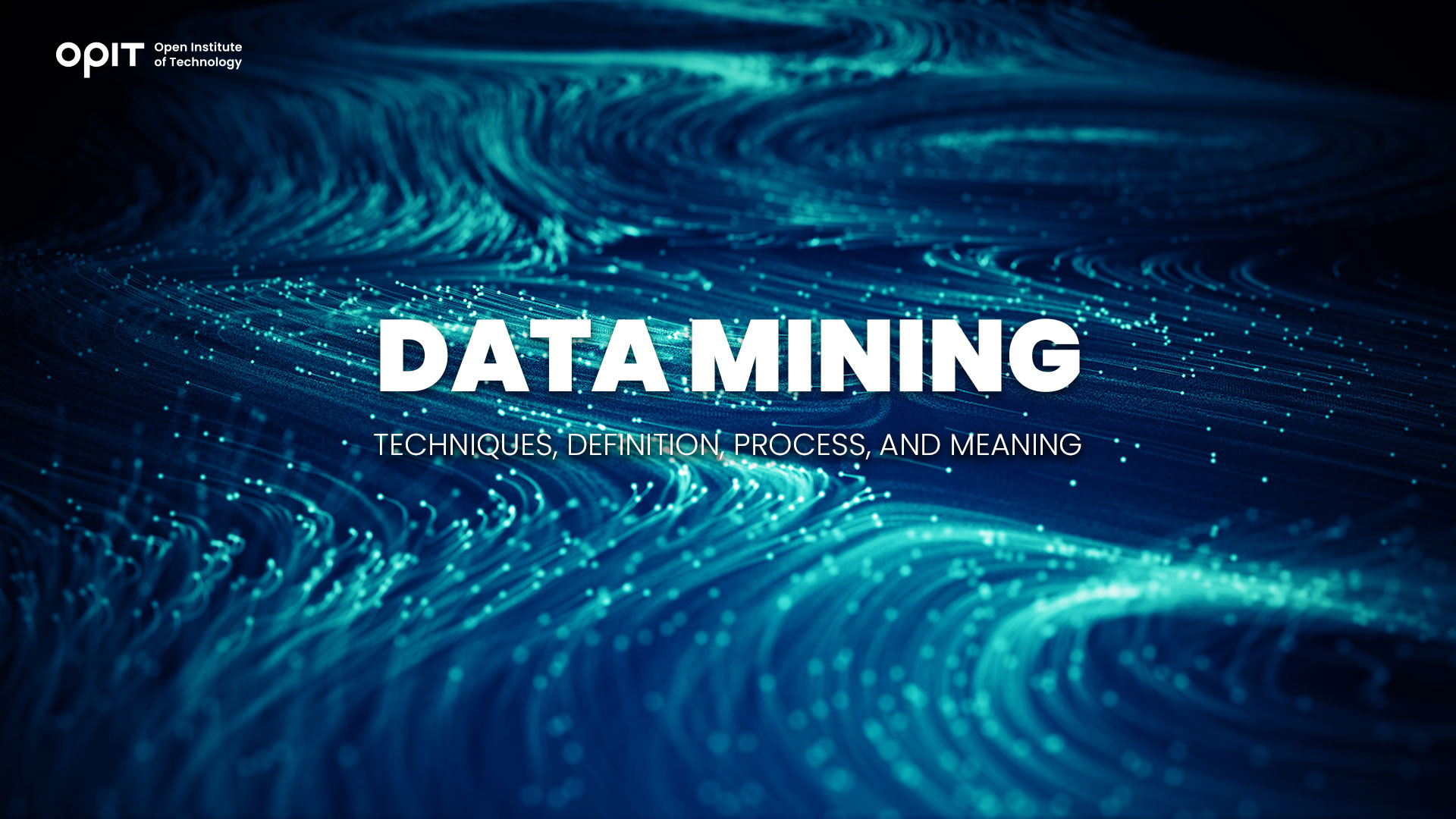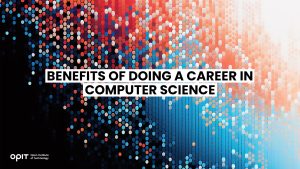

Think for a second about employees in diamond mines. Their job can often seem like trying to find a needle in a haystack. But once they find what they’re looking for, the feeling of accomplishment is overwhelming.
The situation is similar with data mining. Granted, you’re not on the hunt for diamonds (although that wouldn’t be so bad). The concept’s name may suggest otherwise, but data mining isn’t about extracting data. What you’re mining are patterns; you analyze datasets and try to see whether there’s a trend.
Data mining doesn’t involve you reading thousands of pages. This process is automatic (or at least semi-automatic). The patterns discovered with data mining are often seen as input data, meaning it’s used for further analysis and research. Data mining has become a vital part of machine learning and artificial intelligence as a whole. If you think this is too abstract and complex, you should know that data mining has found its purpose for every company. Investigating trends, prices, sales, and customer behavior is important for any business that sells products or services.
In this article, we’ll cover different data mining techniques and explain the entire process in more detail.
Data Mining Techniques
Here are the most popular data mining techniques.
Classification
As you can assume, this technique classifies something (datasets). Through classification, you can organize vast datasets into clear categories and turn them into classifiers (models) for further analysis.
Clustering
In this case, data is divided into clusters according to a certain criterion. Each cluster should contain similar data points that differ from data points in other clusters.
If we look at clustering from the perspective of artificial intelligence, we say it’s an unsupervised algorithm. This means that human involvement isn’t necessary for the algorithm to discover common features and group data points according to them.
Association Rule Learning
This technique discovers interesting connections and associations in large datasets. It’s pretty common in sales, where companies use it to explore customers’ behaviors and relationships between different products.
Regression
This technique is based on the principle that the past can help you understand the future. It explores patterns in past data to make assumptions about the future and make new observations.
Anomaly Detection
This is pretty self-explanatory. Here, datasets are analyzed to identify “ugly ducklings,” i.e., unusual patterns or patterns that deviate from the standard.
Sequential Pattern Mining
With this technique, you’re also on the hunt for patterns. The “sequential” indicates that you’re analyzing data where the values are in a sequence.
Text Mining
Text mining involves analyzing unstructured text, turning it into a structured format, and checking for patterns.
Sentiment Analysis
This data mining technique is also called opinion mining, and it’s very different from the methods discussed above. This complex technique involves natural language processing, linguistics, and speech analysis and wants to discover the emotional tone in a text.
Data Mining Process
Regardless of the technique you’re using, the data process consists of several stages that ensure accuracy, efficiency, and reliability.
Data Collection
As mentioned, data mining isn’t actually about identifying data but about exploring patterns within the data. To do that, you obviously need a dataset you want to analyze. The data needs to be relevant, otherwise you won’t get accurate results.
Data Preprocessing
Whether you’re analyzing a small or large dataset, the data within it could be in different formats or have inconsistencies or errors. If you want to analyze it properly, you need to ensure the data is uniform and organized, meaning you need to preprocess it.
This stage involves several processes:
- Data cleaning
- Data transformation
- Data reduction
Once you complete them, your data will be prepared for analysis.
Data Analysis
You’ve come to the “main” part of the data mining process, which consists of two elements:
- Model building
- Model evaluation
Model building represents determining the most efficient ways to analyze the data and identify patterns. Think of it this way: you’re asking questions, and the model should be able to provide the correct answers.
The next step is model evaluation, where you’ll step back and think about the model. Is it the right fit for your data, and does it meet your criteria?
Interpretation and Visualization
The journey doesn’t end after the analysis. Now it’s time to review the results and come to relevant conclusions. You’ll also need to present these conclusions in the best way possible, especially if you conducted the analysis for someone else. You want to ensure that the end-user understands what was done and what was discovered in the process.
Deployment and Integration
You’ve conducted the analysis, interpreted the results, and now you understand what needs to be changed. You’ll use the knowledge you’ve gained to elicit changes.
For example, you’ve analyzed your customers’ behaviors to understand why the sales of a specific product dropped. The results showed that people under the age of 30 don’t buy it as often as they used to. Now, you face two choices: You can either advertise the product and focus on the particular age group or attract even more people over the age of 30 if that makes more sense.
Applications of Data Mining
The concept of data mining may sound too abstract. However, it’s all around us. The process has proven invaluable in many spheres, from sales to healthcare and finance.
Here are the most common applications of data mining.
Customer Relationship Management
Your customers are the most important part of your business. After all, if it weren’t for them, your company wouldn’t have anyone to sell the products/services to. Yes, the quality of your products is one way to attract and keep your customers. But quality won’t be enough if you don’t value your customers.
Whether they’re buying a product for the first or the 100th time, your customers want to know you want to keep them. Some ways to do so are discounts, sales, and loyalty programs. Coming up with the best strategy can be challenging to say the least, especially if you have many customers belonging to different age groups, gender, and spending habits. With data mining, you can group your customers according to specific criteria and offer them deals that suit them perfectly.
Fraud Detection
In this case, you analyze data not to find patterns but to find something that stands out. This is what banks do to ensure no unwanted guests are accessing your account. But you can also see this fraud detection in the business world. Many companies use it to identify and remove fake accounts.
Market Basket Analysis
With data mining, you can get answers to an important question: “Which items are often bought together?” If this is on your mind, data mining can help. You can perform the association technique to discover the patterns (for example, milk and cereal) and use this valuable intel to offer your customers top-notch recommendations.
Healthcare and Medical Research
The healthcare industry has benefited immensely from data mining. The process is used to improve decision-making, generate conclusions, and check whether a treatment is working. Thanks to data mining, diagnoses have become more precise, and patients get more quality services.
As medical research and drug testing are large parts of moving the entire industry forward, data mining found its role here, too. It’s used to keep track of and reduce the risk of side effects of different medications and assist in administration.
Social Media Analysis
This is definitely one of the most lucrative applications. Social media platforms rely on it to pick up more information about their users to offer them relevant content. Thanks to this, people who use the same network will often see completely different posts. Let’s say you love dogs and often watch videos about them. The social network you’re on will recognize this and offer you even more dog videos. If you’re a cat person and avoid dog videos at all costs, the algorithm will “understand” this and offer you more videos starring cats.
Finance and Banking
Data mining analyzes markets to discover hidden patterns and make accurate predictions. The process is also used to check a company’s health and see what can be improved.
In banking, data mining is used to detect unusual transactions and prevent unauthorized access and theft. It can analyze clients and determine whether they’re suitable for loans (whether they can pay them back).
Challenges and Ethical Considerations of Data Mining
While it has many benefits, data mining faces different challenges:
- Privacy concerns – During the data mining process, sensitive and private information about users can come to light, thus jeopardizing their privacy.
- Data security – The world’s hungry for knowledge, and more and more data is getting collected and analyzed. There’s always a risk of data breaches that could affect millions of people worldwide.
- Bias and discrimination – Like humans, algorithms can be biased, but only if the sample data leads them toward such behavior. You can prevent this with precise data collection and preprocessing.
- Legal and regulatory compliance – Data mining needs to be conducted according to the letter of the law. If that’s not the case, the users’ privacy and your company’s reputation are at stake.
Track Trends With Data Mining
If you feel lost and have no idea what your next step should be, data mining can be your life support. With it, you can make informed decisions that will drive your company forward.
Considering its benefits, data mining will continue to be an invaluable tool in many niches.
Related posts

Life is unpredictable. While many of us have specific hopes and expectations of how our futures will turn out, things don’t always go as expected. There are many variables and unexpected incidents that can interfere and force you to alter your plans, and this is particularly true when it comes to education.
For instance, you might have had plans to study a specific subject, but had to deviate from those plans due to unforeseen circumstances. Or you may have had to enter the workforce in an occupation different from the one you sought in an effort to earn an income, a move that may not provide you with the time or opportunity to achieve your desired educational aims.
In short, every individual’s career pathway is different, and very few go exactly as we expect from the outset. Fortunately, even if you experience a few false starts or sudden twists in your pathway, there are always options available to help you get back on track.
The Unpredictable Nature of Education
In theory, the educational process seems simple. You select a course of study that interests you from the vast array of subjects and prospective professions, select the appropriate classes, acquire the knowledge and skills you need to succeed, and then embark on your profession.
In reality, however, as many people know from firsthand experience, the road to education is often far from straightforward. Here are just some of the many challenges that can take your educational path in a completely different direction:
- Life’s Curveballs: As touched on in the introduction, life is impossible to predict. Financial hardships, health issues, and family emergencies are just some of the unfortunate occurrences that might derail even the most perfectly planned educational regime.
- Changing Interests: People’s desires and preferences don’t necessarily stay the same throughout their entire lives. As you grow, learn, and have new experiences, your interests may change, and so, too, may your educational objectives.
- Pressure and Burnout: Some academic paths are particularly challenging, demanding intense levels of study and hard work. This can sometimes prove too much to bear, even for the most resilient students.
- Failures and Setbacks: Conventional education largely builds around tests and examinations, requiring students to demonstrate their competencies repeatedly. It’s a system that doesn’t suit everyone, and test failures can lead to setbacks and delays.
- Inequality: People can be born with very different privileges and levels of access to education. Those in certain parts of the world may find it much more challenging to complete their education path for financial, cultural, or even political reasons.
- Late Bloomers: People develop at different paces. Some may struggle educationally early on in their lives, forcing them to make certain concessions or sacrifices related to their studies, only to find their feet later in life once they’ve entered the world of work.
Whether you’re a late bloomer, have had your educational aspirations delayed by personal problems, desire to learn new skills and try something different, or want to begin a fresh chapter in your professional life, the Open Institute of Technology (OPIT) may be able to help.
Introducing OPIT
OPIT is an online teaching platform, making high-level technological educational programs accessible to all, no matter their age or background. Offering education in fields like computer science, artificial intelligence, and digital business, OPIT provides a curated collection of degrees. In addition, they offer classes taught by world-leading tutors imparting the wisdom and skills students need to achieve their goals and become the tech leaders of tomorrow.
Meanwhile, for those who have had somewhat tumultuous or unpredictable educational paths, OPIT offers the perfect course corrector: the OPIT Foundation Year.
The OPIT Foundation Year
OPIT’s Foundation Year is a Pre-Tertiary Certificate in Information Technology, fully aligned with MQF/EQF Level 4 standards and valued at 60 ECTS credits. Lasting just one year, this program essentially serves as a comprehensive yet accessible springboard towards higher-level education, creating a path towards degrees and careers in dynamic, flexible fields, like computer science and digital business.
Like other OPIT programs, the Foundation Year is delivered entirely online via the OPIT Virtual Learning Environment. Combining live lectures, asynchronous content, and interactive assessments, students enjoy diverse and dynamic study experiences, acquiring core skills like academic writing, mathematics, and computer literacy, and building a bedrock of knowledge and confidence before taking their next steps.
Who Is the Foundation Program For?
The Foundation Program is designed to provide a solid base upon which to build the technological education many students need. It’s the perfect choice for those who are eager and ambitious to enter professions in AI, data science, and computing, but don’t feel that they have the necessary core skills and knowledge needed to dive straight into a degree.
Entry requirements are relatively relaxed in order to allow as many students as possible to enjoy the benefits of this program. With that said, applicants should ideally hold an MQF/EQF Level 3 or equivalent qualification, with the intention of pursuing a bachelor’s degree. A minimum of B2 level of English proficiency is also required, as this is the working and studying language of the institution.
What the Foundation Year Provides
Perhaps you’ve recently graduated, are considering a career change, or finally have the opportunity to return to education after initial delays or unexpected disruptions to your original plans. Either way, the Foundation Year can help you enjoy:
- Greater Self-Confidence: Foundation Year graduates gain the fundamental skills they need to enter degree programs with much more self-belief and assuredness.
- Superior Tech Knowledge: Lasting two terms, this course explores mathematics, academic reading and writing, and provides an introduction to computer hardware and software.
- Foundational Mathematics: Mathematics literacy forms a large part of the study focus for the Foundation Year, helping students feel more comfortable with numbers and formulas.
- Flexible Learning: Unlike more rigid, conventional education environments, OPIT gives you the freedom and flexibility to study at a pace that suits you best, all from the comfort of home.
- Global Community: OPIT is an international institution, with staff and students from all around the world eager to share knowledge, exchange ideas, and help one another.
Take Your Next Steps to Success With the OPIT Foundation Year
If you’re curious about a career in technology or have always wanted to work with AI, data, and computers, but struggled to find the time and opportunities you need to acquire relevant skills and knowledge, the Foundation Program was made for people like you.
It’s the ideal entry point into the exciting world of online education, and the perfect first step towards a prestigious degree from an innovative and increasingly successful institution. Download the brochure to learn more about it, or start your online application, today.

Students today have a broader range of fields of study to choose from than ever before, but with the world becoming increasingly technological and computers increasing in influence and importance, pursuing a career in computer science often proves a smart, strategic choice.
There are numerous benefits and career paths associated with studying and working in computer science, and we’ll be listing just a few of them in this guide.
High Average Salaries
With the rising cost of living in many parts of the world, it’s unsurprising that many students are thinking several decades ahead to determine what level of starting salaries they could obtain in different career fields.
Many are also seeking professions that offer the opportunity for growth and the ability to advance up the ranks over time, thus increasing their salary and their quality of life in the process.
If a strong, stable salary with the opportunity for improved income is one of your top career priorities, computer science should be at or near the top of your list of prospective careers.
According to recent data, computer scientists earn an average of over €65,000 per year, with certain jobs, like IT project leader and data scientist, paying ever higher. Starting salaries are strong, too, with graduates earning anywhere from €46,000 to €60,000, depending on their chosen profession and level of qualifications.
There are similarly high average salaries reported around the world in computer science and related fields such as data science and AI/ML engineering. These numbers are projected to increase in the years to come, pointing to computer science as a way for graduates to get off to the best financial start of any career.
Unrivaled Flexibility
A common problem with some subjects and courses is that they only provide graduates with a narrow set of skills and a similarly narrow range of potential professions to which they can apply those skills.
That’s not the case with computer science. Graduates in this field can enjoy instant access to a remarkably diverse array of career opportunities, with even newer opportunities being created all the time as technology evolves and innovations emerge.
A few of the many industries and roles you might choose to enter in the field of computer science include:
- Healthcare: As a software developer, data analyst, or cybersecurity expert
- Finance: As a fintech engineer, blockchain developer, or security analyst
- Media: As a graphics programmer, AI developer, or game developer
- Education: As an analyst, software developer, or machine learning engineer
Guaranteed Opportunities
Some career paths are more limited than others, with relatively low numbers of opportunities, recurring risks of job loss, or difficulty obtaining employment in the first place.
Again, with computer science, this simply isn’t the case. At a time when 75% of companies plan to embrace AI and other technologies by 2027, and businesses of all sizes and industries are now relying on computers more than ever before, computer science graduates can enjoy almost unbeatable job security.
Opportunities will continue to grow for people with good computing knowledge, whether that be in the obvious fields like software and web development, engineering, and AI development, or more niche sectors.
With so many options, you’re effectively guaranteed a long, rewarding career if you put in the necessary time and effort needed to establish a strong foundation of computing skills.
Rapidly Expanding and Evolving Industries
It’s no secret that the world of technology is a dynamic and fast-moving one. In the past 20 years alone, we’ve seen the proliferation of the internet, the rapid advancement of smartphones and wearable devices, the emergence of AI, and so much more.
In the years ahead, engineers and developers will continue to explore the boundaries of modern technology’s powers and potential, driving new innovations and improvements and opening more exciting job opportunities for those already established and experienced in this field.
Getting into computer science now could therefore provide a solid foundation for a career filled with excitement as you uncover and explore new ways of working with computers in fields as diverse as healthcare, finance, education, entertainment, manufacturing, logistics, and beyond.
Start Your Computer Science Career at OPIT
We’ve discussed some of the many benefits associated with careers in computer science, from the high starting salaries to the rapidly growing array of job options available to graduates. By now, you may be eager to follow this particular career path and take advantage of the wealth of opportunities.
If you’re wondering how to start, the Open Institute of Technology (OPIT) may hold the answers you need. As an exclusively online learning platform, specializing in computer science and digital business, and staffed by some of the world’s leading tech experts, OPIT is producing the tech leaders of tomorrow.
Some of the many advantages of learning with OPIT include:
- Accessible and flexible online education that matches your learning style and schedule
- Heavy focus on real-world applications of the skills you acquire
- An international community of like-minded students from around the globe
- A top team of tutors and lecturers from varying fields and industries
- Progressive assessment of skills and understanding – not constant exams
OPIT offers a small, curated selection of courses for those seeking to gain the technological skills and knowledge to succeed in their chosen areas of expertise. That includes a BSc (Hons) in Computer Science – a six-term program, worth 180 ECTS credits.
Numerous IT industry leaders and experts helped develop this fully accredited undergraduate degree, which is online and accessible to all. Like other OPIT courses, it offers a flexible learning program, with progressive assessments, fast-track options, and the opportunity to be part of a growing community of learners and tutors.
If the benefits of doing a career in computer science interest you, download the OPIT BSc in Computer Science brochure or fill out an online application today and take your first step toward a rewarding and fulfilling profession.
Have questions?
Visit our FAQ page or get in touch with us!
Write us at +39 335 576 0263
Get in touch at hello@opit.com
Talk to one of our Study Advisors
We are international
We can speak in:


